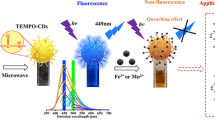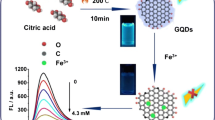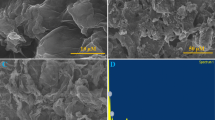Abstract
The development of a bio-based fluorescent membrane sensor for iron ions is elaborated. A three-dimensional (3D) network structure of bacterial cellulose (BC) made by layer-by-layer in situ cultivation contained nitrogen doped graphene oxide quantum dots (N-GOQDs). The obtained BC/N-GOQDs were analyzed by SEM, TEM and XPS and demonstrated that the blue emissive N-GOQDs were homogeneously distributed in the BC mats through hydrogen bonding. These materials were found to be useful for the detection of iron ions in aqueous solutions. Experimental data showed the blue-emitting BC/N-GOQDs fluorescent probes exhibited a sensitive response to Fe3+ within a favorable concentration range of 0.5–650 μM with a very good lower limit detection of 69 nM at a signal-to-noise ratio of 3 (S/N = 3). Meanwhile, the BC/N-GOQDs–Fe3+ complexes has good reproducibility after treatment with EDTA. The quenching mechanism was attributed to strong coordination between surface functional groups (–NH2 and –OH) and Fe3+ which was successfully applied in real water samples.
Graphical abstract
Diagram of quenching mechanism of the BC/N-GOQDs nanocomposites towards Fe3+ ions.












Similar content being viewed by others
References
Bradley SJ, Kroon R, Laufersky G, Röding M, Goreham RV, Gschneidtner T, Schroeder K, Moth-Poulsen K, Andersson M, Nann T (2017) Heterogeneity in the fluorescence of graphene and graphene oxide quantum dots. Microchim Acta 184(3):871–878
Chen LF, Huang ZH, Liang HW, Guan QF, Yu SH (2013) Bacterial-cellulose-derived carbon nanofiber@MnO2 and nitrogen-doped carbon nanofiber electrode materials: an asymmetric supercapacitor with high energy and power density. Adv Mater 25(34):4746–4752
Chen Y, Wu Y, Weng B, Wang B, Li C (2016) Facile synthesis of nitrogen and sulfur co-doped carbon dots and application for Fe3+ detection and cell imaging. Sens Actuators B Chem 223:689–696
Chen L, Ma N, Park Y, Jin S, Hwang H, Jiang D, Jung YM (2017) Highly sensitive determination of Fe3+ based on phenanthroline probe: surface-enhanced Raman spectroscopy methods. Spectrochim Acta A 197:43–46
Chen S, Xu CH, Yu YL, Wang JH (2018) Multichannel fluorescent sensor array for discrimination of thiols using carbon dot–metal ion pairs. Sens Actuators B Chem 266:553–560
Du Y, Guo S (2016) Chemically doped fluorescent carbon and graphene quantum dots for bioimaging, sensor, catalytic and photoelectronic applications. Nanoscale 8(5):2532–2543
Fu L, Zhang J, Yang G (2013) Present status and applications of bacterial cellulose-based materials for skin tissue repair. Carbohydr Polym 92(2):1432–1442
Gao X, Lu Y, He S, Li X, Chen W (2015) Colorimetric detection of iron ions (III) based on the highly sensitive plasmonic response of the N-acetyl-l-cysteine-stabilized silver nanoparticles. Anal Chim Acta 879:118–125
Ge G, Jiang YW, Jia HR, Yang J, Wu FG (2018) On–off–on fluorescent nanosensor for Fe3+ detection and cancer/normal cell differentiation via silicon-doped carbon quantum dots. Carbon 134:232–243
Gill R, Zayats M, Willner I (2008) Semiconductor quantum dots for bioanalysis. Angew Chem Int Ed 47(40):7602–7625
Hassan M, Gomes VG, Dehghani A, Ardekani SM (2018) Engineering carbon quantum dots for photomediated theranostics. Nano Res 11(1):1–41
Hu W, Chen S, Yang J, Li Z, Wang H (2014) Functionalized bacterial cellulose derivatives and nanocomposites. Carbohydr Polym 101(1):1043–1060
Jiang F, Chen D, Li R, Wang Y, Zhang G, Li S, Zheng J, Huang N, Gu Y, Wang C (2013) Eco-friendly synthesis of size-controllable amine-functionalized graphene quantum dots with antimycoplasma properties. Nanoscale 5(3):1137–1142
Ju J, Chen W (2014) Synthesis of highly fluorescent nitrogen-doped graphene quantum dots for sensitive, label-free detection of Fe (III) in aqueous media. Biosens Bioelectron 58(10):219–225
Klemm D, Schumann D, Udhardt U, Marsch S (2001) Bacterial synthesized cellulose—artificial blood vessels for microsurgery. Prog Polym Sci 26(9):1561–1603
Kmetov V, Stefanova V, Hristozov D, Georgieva D, Canals A (2003) Determination of calcium, iron and manganese in moss by automated discrete sampling flame atomic absorption spectrometry as an alternative to the ICP–MS analysis. Talanta 59(1):123–136
Li L, Li L, Wang C, Liu K, Zhu R, Qiang H, Lin Y (2015) Synthesis of nitrogen-doped and amino acid-functionalized graphene quantum dots from glycine, and their application to the fluorometric determination of ferric ion. Microchim Acta 182(3–4):763–770
Lin L, Rong M, Luo F, Chen D, Wang Y, Chen X (2014) Luminescent graphene quantum dots as new fluorescent materials for environmental and biological applications. TrAC Trends Anal Chem 54:83–102
Liu H, Na W, Liu Z, Chen X, Su X (2017a) A novel turn-on fluorescent strategy for sensing ascorbic acid using graphene quantum dots as fluorescent probe. Biosens Bioelectron 92:229–233
Liu Q, Ma C, Liu XP, Wei YP, Mao CJ, Zhu JJ (2017b) A novel electrochemiluminescence biosensor for the detection of microRNAs based on a DNA functionalized nitrogen doped carbon quantum dots as signal enhancers. Biosens Bioelectron 92:273–279
Lu W, Gong X, Nan M, Liu Y, Shuang S, Dong C (2015) Comparative study for N and S doped carbon dots: synthesis, characterization and applications for Fe3+ probe and cellular imaging. Anal Chim Acta 898:116–127
Lv P, Yao Y, Li D, Zhou H, Naeem MA, Feng Q, Huang J, Cai Y, Wei Q (2017a) Self-assembly of nitrogen-doped carbon dots anchored on bacterial cellulose and their application in iron ion detection. Carbohydr Polym 172:93–101
Lv P, Yao Y, Zhou H, Zhang J, Pang Z, Ao K, Cai Y, Wei Q (2017b) Synthesis of novel nitrogen-doped carbon dots for highly selective detection of iron ion. Nanotechnology 28(16):165502
Lv P, Zhou H, Zhao M, Li D, Lu K, Wang D, Huang J, Cai Y, Lucia LA, Wei Q (2018) Highly flexible, transparent, and conductive silver nanowire-attached bacterial cellulose conductors. Cellulose 25(6):3189–3196
Qiao Y, Liu C, Zheng X (2018) Enhancing the quantum yield and Cu2+ sensing sensitivity of carbon dots based on the nano-space confinement effect of silica matrix. Sens Actuators B Chem 259:211–218
Qu K, Wang J, Ren J, Qu X (2013) Carbon dots prepared by hydrothermal treatment of dopamine as an effective fluorescent sensing platform for the label-free detection of Fe3+ and dopamine. Chemistry 19(22):7243–7249
Resch-Genger U, Grabolle M, Cavaliere-Jaricot S, Nitschke R, Nann T (2008) Quantum dots versus organic dyes as fluorescent labels. Nat Methods 5(9):763–775
Schnitzenbaumer KJ, Dukovic G (2014) Chalcogenide-ligand passivated CdTe quantum dots can be treated as core/shell semiconductor nanostructures. J Phys Chem C 118(48):28170–28178
Shangguan J, Jin H, He D, He X, Wang K, Ye R, Xue Y, Qing T, Tang J (2017) Highly Fe3+-selective fluorescent nanoprobe based on ultrabright N/P codoped carbon dots and its application in biological samples. Anal Chem 89(14):7477–7484
Shi Q, Li Y, Sun J, Zhang H, Chen L, Chen B, Yang H, Wang Z (2012) The osteogenesis of bacterial cellulose scaffold loaded with bone morphogenetic protein-2. Biomaterials 33(28):6644–6649
Wang C, Sun J, Mei H, Gao F (2016a) Organic semiconductor polymer nanodots as a new kind of off–on fluorescent probe for sulfide. Microchim Acta 184(2):1–7
Wang R, Wang X, Sun Y (2016b) One-step synthesis of self-doped carbon dots with highly photoluminescence as multifunctional biosensors for detection of iron ions and pH. Sens Actuators B Chem 241:73–79
Wu H, Jiang J, Gu X, Tong C (2017) Nitrogen and sulfur co-doped carbon quantum dots for highly selective and sensitive fluorescent detection of Fe(III) ions and l-cysteine. Microchim Acta 184(7):2291–2298
Wu S, Li W, Zhou W, Zhan Y, Hu C, Zhuang J, Zhang H, Zhang X, Lei B, Liu Y (2018) Large-scale one-step synthesis of carbon dots from yeast extract powder and construction of carbon dots/PVA fluorescent shape memory material. Adv Opt Mater 6(7):1701150
Xiong R, Grant AM, Ma R, Zhang S, Tsukruk VV (2018) Naturally-derived biopolymer nanocomposites: interfacial design, properties and emerging applications. Mater Sci Eng R 125:1–41
Xu Q, Zhao J, Liu Y, Pu P, Wang X, Chen Y, Gao C, Chen J, Zhou H (2015) Enhancing the luminescence of carbon dots by doping nitrogen element and its application in the detection of Fe3+. J Mater Sci 50(6):2571–2576
Xu Q, Yuan H, Dong X, Zhang Y, Asif M, Dong Z, He W, Ren J, Sun Y, Xiao F (2018) Dual nanoenzyme modified microelectrode based on carbon fiber coated with AuPd alloy nanoparticles decorated graphene quantum dots assembly for electrochemical detection in clinic cancer samples. Biosens Bioelectron 107:153–162
Yang H, Zhu C, Yang J, Nie Y, Chen C, Sun D (2014) Recent advances in bacterial cellulose. Cellulose 21(1):1–30
Yeh TF, Chen SJ, Teng H (2015) Synergistic effect of oxygen and nitrogen functionalities for graphene-based quantum dots used in photocatalytic H2 production from water decomposition. Nano Energy 12:476–485
Zhang T, Wang W, Zhang D, Zhang X, Ma Y, Zhou Y, Qi L (2010) Biotemplated synthesis of gold-nanoparticle-bacteria cellulose nanofiber nanocomposites and their application in biosensing. Adv Funct Mater 20(7):1152–1160
Zhang H, Chen Y, Liang M, Xu L, Qi S, Chen H, Chen X (2014) Solid-phase synthesis of highly fluorescent nitrogen-doped carbon dots for sensitive and selective probing ferric ions in living cells. Anal Chem 86(19):9846–9852
Zheng XT, Ananthanarayanan A, Luo KQ, Chen P (2015) Glowing graphene quantum dots and carbon dots: properties, syntheses, and biological applications. Small 11(14):1620–1636
Zhu X, Zhang Z, Xue Z, Huang C, Shan Y, Liu C, Qin X, Yang W, Chen X, Wang T (2017) Understanding the selective detection of Fe3+ based on graphene quantum dots as fluorescent probes: the Ksp of a metal hydroxide-assisted mechanism. Anal Chem 89(22):12054–12058
Acknowledgments
This research was financially supported by National First-Class Discipline Program of Light Industry Technology and Engineering (LITE2018-21), the National Key R&D Program of China (2017YFB0309100), the 111 Project (B17021), the State Scholarship Fund from China Scholarship Council (201706790088), the Innovation Program for Graduate Education in Jiangsu Province (KYLX16_0794), the Department of Education in Anhui Province of China (2015LJRCTD001), the National Natural Science Foundation of China (51803078), the Natural Science Foundation of Jiangsu Province (SBK2018041756), and the Fundamental Research Funds for the Central Universities (JUSRP11701).
Author information
Authors and Affiliations
Corresponding authors
Ethics declarations
Conflict of interest
The authors declare that they have no conflict of interests.
Additional information
Publisher's Note
Springer Nature remains neutral with regard to jurisdictional claims in published maps and institutional affiliations.
Electronic supplementary material
Below is the link to the electronic supplementary material.
Rights and permissions
About this article
Cite this article
Lv, P., Zhou, H., Mensah, A. et al. In situ 3D bacterial cellulose/nitrogen-doped graphene oxide quantum dot-based membrane fluorescent probes for aggregation-induced detection of iron ions. Cellulose 26, 6073–6086 (2019). https://doi.org/10.1007/s10570-019-02476-z
Received:
Accepted:
Published:
Issue Date:
DOI: https://doi.org/10.1007/s10570-019-02476-z




